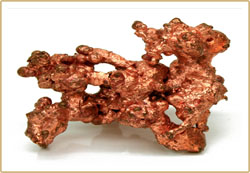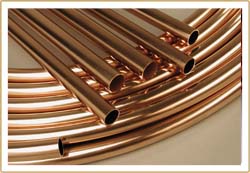Copper
Copper
Copper: Copper is a reddish-coloured metal, with a high electrical and thermal conductivity (among pure metals at room temperature, only Silver has a higher electrical conductivity). Copper may well be the oldest metal in use, as Copper artifacts dating to 8700 BC have been found. Besides being part of various Ores, Copper can be found in the metallic form (i.e. Native Copper) in some locations.
There are numerous alloys of Copper - speculum metal is a Copper/Tin alloy, Brass is a Copper/Zinc alloy, and Bronze is a Copper/Tin alloy. Monel metal is a Copper/Nickel alloy, also called Cupronickel.
Copper is malleable and ductile, and is used extensively, in products such as:
- Copper wire.
- Copper plumbing.
- Doorknobs and other fixtures in houses.
- Electromagnets.
- Motors, esp electromagnetic motors.
- Watt's steam engine.
- Electrical relays, electrical busbars and electrical switches.
- Vacuum tubes, cathode ray tubes, and the magnetrons in microwave ovens.
- Wave guides for microwave radiation.
- There is increasing use of copper in integrated circuits, replacing aluminium because of its superior conductivity.
- Alloyed with nickel, e.g. cupronickel and Monel, used as corrosive resistant materials in shipbuilding.
- As a component of coins, often as cupronickel alloy.
- In cookware, such as frying pans.
- Sterling silver, if it is to be used in dinnerware, must contain a few percent copper.
- As a component in ceramic glazes, and to color glass.
- Musical instruments, especially brass instruments.
- As a biostatic surface in hospitals, and to line parts of ships to protect against barnacles and mussels. Bacteria will not grow on a copper surface because it is biostatic. Copper doorknobs are used by hospitals to reduce the transfer of disease, and Legionnaire's Disease is suppressed by copper tubing in air-conditioning systems.
- Compounds, such as Fehling's solution, have applications in chemistry.


